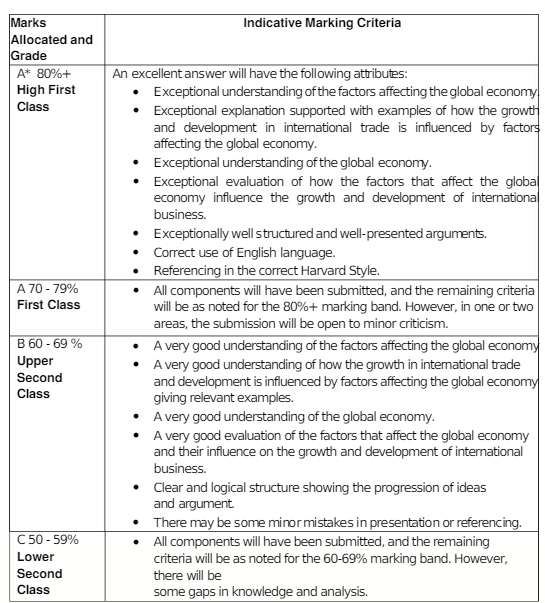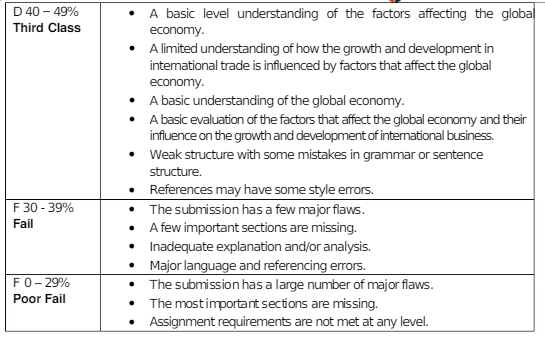LSME504 Intemational Business L5 Assignment Brief 2025
Learning Outcomes of LSME504:
Upon successful completion of this module students will be able to:
- Explain and give examples of how the growth in international trade is influenced by factors affecting the global economy.
- Analyse how the global business environment influences the growth and development of international business.
- Identify and illustrate how socio-economic cultures and technological developments affect international business.
- Analyse and explain how the political environment and ecological considerations affect international business decisions.
MODULE DESCRIPTION
Technological and economic developments are reducing barriers to international trade and increasing global business opportunities. The module examines the forces shaping the international business environment and the factors creating new market opportunities, and how these determine the strategy of international organizations. In particular, new forms of organization are being created by multinationals, which can create opportunities for small and medium-sized enterprises to participate in the value chain of global players.
LSME504 Assignment Task 1: Essay
Globalisation and international business relate to the global economy. With this in mind, analyse how factors affecting the global economy and the global business environment influence the growth and development of international trade.
Assignment Task 1 Essay Marking Criteria


Are You Looking for Answer of LSME504 Assignment
Order Non Plagiarized Assignment
LSME504 Assignment 2: Case Study
Case Study of Toyota Motor Corporation
Founded in 1937, Toyota Motor Corporation is a Japanese company that designs, manufactures, assembles, and sells passenger cars, minivans, commercial vehicles, and related parts and accessories, primarily in Japan, North America, Europe, and Asia. Current brands include Toyota, Lexus, Daihatsu, and Hino. Toyota Motor Corporation is the leading auto manufacturer and the eighth largest company in the world.
Toyota Motor Corporation competes in the automotive industry. The company has faced challenges typical for automobile manufacturers, such as skyrocketing fuel prices and growing environmental concerns that have shifted consumer preferences. The global economy has undergone various transitions, including the global financial crisis and the COVID-19 pandemic, which have led to downtimes for businesses. These challenges have impacted employment scenarios across different countries and have been influenced by various economic factors, such as the weak yen versus the U.S. dollar, the growth of the U.S. economy, and the rapid development of emerging markets. These factors present opportunities for Toyota to improve its exports from Japan, leveraging the weakness of the Japanese yen. Additionally, the U.S., one of the world’s largest automobile markets, offers significant growth potential. The rapid growth of developing economies also provides an opportunity for the firm to increase revenues in these markets.
Sociocultural factors that influence Toyota’s business environment affect its customers and their buying behaviors. Toyota has observed an increasing interest in hybrid and electric cars. However, the company also faces threats, such as the widening wealth gap among different demographics, which could lead to a decline in demand for cars in certain market segments. Therefore, it is crucial for Toyota to stay aware of the social dynamics within the industry environment. By adapting to these social situations, the company can more effectively appeal to its target customers. Social factors play a significant role in the success of Toyota’s marketing strategies.
Moreover, Toyota operates in various political environments that impact its global businesses. The company must navigate different govemmental regulations and policies across countries. Significant macro-environmental factors demand political stability in major markets, the establishment of free-trade agreements for market penetration, and governmental support for eco- friendly products. These factors are essential for Toyota to improve its vehicles and meet or exceed environmentally focused standards based on political trends.
Toyota is advancing its vision of a “green factory” by integrating the latest technologies to create more sustainable and efficient production processes. This initiative is driven by three key technologies: automated conveyance, automated inspection using Al, and digital transformation (DX) through loT. In terms of automated conveyance, Toyota views the act of transporting materials as inherently wasteful. The ideal scenario is to eliminate transportation altogether. However, since complete elimination is often impractical, Toyota focuses on minimizing transportation distances and optimizing the process. The company revises facility layouts to reduce the distance between point A and point B, decreasing the bulk of cargo and minimizing the number of items per load. Once these distances are minimized, Toyota implements an automated conveyance system to cover only the remaining distance, designed to carry the lightest possible loads. This concept is also applied in Woven City, where roads above and below ground are developed separately. Underground roads are dedicated to fully automated logistics vehicles, streamlining goods distribution.
Toyota leverages artificial intelligence for automated inspection processes aimed at defect prevention, which reduces the need for human labor. Toyota’s approach goes a step further by using the vast amounts of data collected from these inspections to make essential improvements that prevent defects from occurring in the first place. Digital transformation and the Internet of Things (IoT) are central to Toyota’s technological advancements, ensuring continuous improvement and raising equipment utilization rates on production lines to 98 percent, with the remaining 2 percent managed by employees. Additionally, Toyota focuses on various software and connected initiatives, emphasizing real-world applications, internalization, software updates, and the exploration of the future of the auto industry in a connected world.
Toyota is taking on the challenge of creating a “green factory” on various fronts, with the goal of reducing CO2 emissions from its plants worldwide to zero, achieving carbon neutrality by 2035. This target, announced in June 2021, reflects Toyota’s belief that striving for carbon neutrality presents an opportunity to fundamentally innovate manufacturing. Toyota also promotes the development of fully electrified vehicles equipped with batteries. These development efforts are organized by the type of electrified vehicle to ensure that customers satisfaction. The company focuses on producing products that are balanced with safety, long service life, high-level quality, affordability, and outstanding performance. Furthermore, Toyota is engaged in various initiatives aimed at achieving carbon neutrality.
ASSIGNMENT TASK:
Based on the case study given above identify and illustrate how socio-economic cultures and technological developments affect intemational business for Toyota. Additionally, analyse and explain how the political environment and ecological considerations impact Toyota’s international business decisions.

